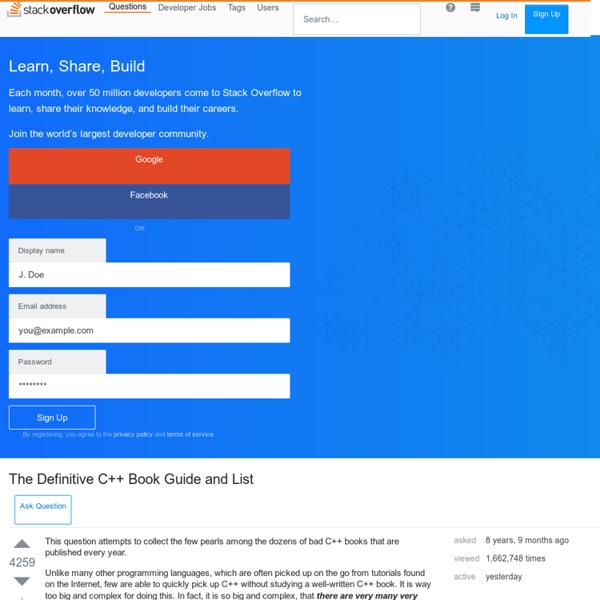



http://stackoverflow.com/questions/388242/the-definitive-c-book-guide-and-list
Bruce Eckel's MindView, Inc: Thinking in C++, Volume 1<br>Solution Guide This page describes the Annotated Solution Guide for the book Thinking in C++, 2nd Edition, Volume 1 by Bruce Eckel. The solution guide was written by Chuck Allison. The solution guide may be purchased for 12$ USD, and is available as an electronic book only. The guide consists of a set of HTML pages, one for each chapter, and a source-code 'tree' containing all the code from the guide in a compilable form, along with makefiles.
How to Run Android Apps on Your Desktop the Easy Way Ever feel like running an Android app on your Windows machine? Using BlueStacks, you can easily get apps from your Android device to your desktop or laptop without any complicated set up or fussing with the Android SDK. Android Apps on Windows
The Java™ Tutorials The Java Tutorials have been written for JDK 8. Examples and practices described in this page don't take advantage of improvements introduced in later releases and might use technology no longer available.See Java Language Changes for a summary of updated language features in Java SE 9 and subsequent releases.See JDK Release Notes for information about new features, enhancements, and removed or deprecated options for all JDK releases. The Java Tutorials are practical guides for programmers who want to use the Java programming language to create applications. They include hundreds of complete, working examples, and dozens of lessons. Groups of related lessons are organized into "trails".
Students - Guide to Technical Development - Google Careers This guide provides tips and resources to help you develop your technical skills (academically and non-academically) through self-paced, hands-on learning. This guide is intended for Computer Science students seeking an internship or university grad role at Google. What this guide is for You can use this guide to determine which courses to take, but be sure stay on track with your courses required for your major to graduate. We encourage you to learn more outside of this guide.
C / C++ Language A simple introduction to static and dynamic libraries with Microsoft Visual C++. C++, Visual-Studio, Dev, Virtualization, virtual-machine This article gives a brief overview of C style bitwise operators A simple introduction to static and dynamic libraries with GCC. An ideal source package for introducing students to the basics of Win32 programming 1. The way of the program — How to Think Like a Computer Scientist: Learning with Python 2nd Edition documentation The goal of this book is to teach you to think like a computer scientist. This way of thinking combines some of the best features of mathematics, engineering, and natural science. Like mathematicians, computer scientists use formal languages to denote ideas (specifically computations).
Card Design This document goes over how to follow Glass style and implement common UI best practices when using the GDK. Glass theme Glass applies a standard theme to your Glassware, so it stays consistent with the rest of the user interface. The theme has the following characteristics: Uses Roboto typefaceDisplays activities full-screen with no status bar or action barApplies solid, black background
Programming - Exercise Solutions Modified January 17, 2010. This is a collection of solutions for exercises in Programming: Principles and Practice using C++. Comments, improvements, bug reports, solutions, etc. are most welcome. In particular, I'd like to hear if someone thinks that a reasonable solution cannot be provided using the facilities described in the book "so far." My ideals for solutions are: every program (unless stated otherwise) either produces a correct result or gives a reasonably clear error message. no solution gratuitously violates the rules for good programming and design style promoted by the book (even though early solutions obviously can't use significant features only introduced in later chapters). a solution does not use facilities not yet presented in the book. every program is reasonably (but not verbosely) commented with comments appropriate for somone who has read the book thus far. significant design choices are explicitly (if briefly) decribed.
Why H2O? H2O is for data scientists and business analysts who need scalable and fast machine learning. H2O is an open source predictive analytics platform. Unlike traditional analytics tools, H2O provides a combination of extraordinary math and high performance parallel processing with unrivaled ease of use. H2O speaks the language of data science with support for R, Python, Scala, Java and a robust REST API. Smart business applications are powered by H2O’s NanoFastTM Scoring Engine. Get H2O! Frontiers of Computational Thinking: A SXSW Report—Stephen Wolfram Blog Last week I spoke at SXSW Interactive 2015 in Austin, Texas. Here’s a slightly edited transcript: A Most Productive Year Well, hello again. I’ve actually talked about computation three times before at SXSW. And I have to say when I first agreed to give this talk, I was worried that I would not have anything at all new to say.